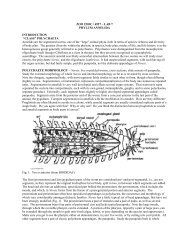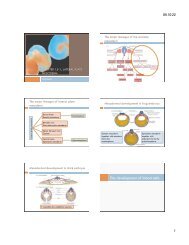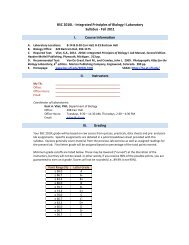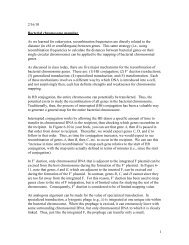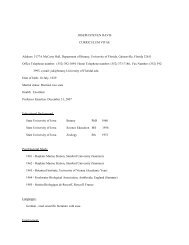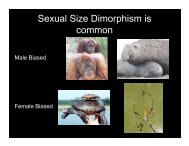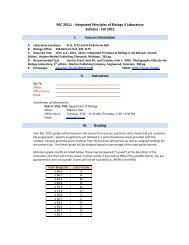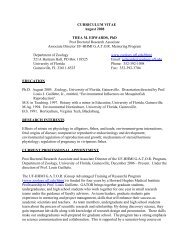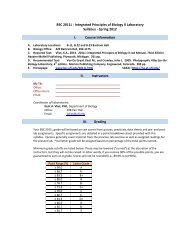Lecture Notes 7: Annelida
Lecture Notes 7: Annelida
Lecture Notes 7: Annelida
Create successful ePaper yourself
Turn your PDF publications into a flip-book with our unique Google optimized e-Paper software.
- grooved feeding palps – only in Canalipalpata; tend to be U shaped, with ciliated path in groove serving to<br />
transport food. Grooved palps dorsal and attached at prostomial-peristomial junction. Include paired spionid<br />
palps, multiple terebellid tentacles (arise from prostomium), radioles of sabellids, buccal tentacles (again<br />
multiple – e.g. Pectinariidae)<br />
Segments: each w/ own separate, paired coelomic compartments; separated by septa & mesenteries.<br />
Body wall:<br />
Cuticle (collagenous, may contain scleroprotein),<br />
Epidermis, circular, longitudinal muscle, peritoneum.<br />
Circular muscle as sheet, long muscle in 4 bands in almost all (Rouse & Fauchald 1997)<br />
Parapodia:<br />
Notopodium, neuropodium, if loose one always loose notopodium.<br />
Nereid type advanced, primitively low, brasing structures, without aciculas, little musculature, noto- and neuropodia<br />
separate.<br />
In evolution may become more muscular and gain aciculae (in Aciculata) and gain strong intrinsic musculature for<br />
chaetae & whole paddle; for swimming, etc. Or reduced to chaetae only (clitellates). Dorsal and ventral cirri –<br />
fleshy extensions; funky chaetae – aphroditids; scale of polynoids; specialized gills<br />
Parapodial muscles evolve from circular musculature<br />
Dorsal and ventral cirrus – outgrowths of body wall – mainly in Aciculata<br />
Aciculae – in Aciculata only. Fully internalized chaetae, with strong muscles that help support and move large<br />
parapodia. Neuropodia have it, notopodial aciculae also in many Eunicida and Phyllodocida<br />
Neuropodia reduced to low welts = tori in many Scolecida & Canalipalpata<br />
Chaetae: Chitinous, produced by chaetoblasts, has dynamic microvilli w/ start & stop activities, make complex<br />
morphologies as a result. Variety of chaetal types, hooks, capillaries, uncini, compound. Chitin restricted to<br />
protostomes. Setae - term for arthropod cuticle-coated structure w/ core of cells -- chaetae solid, secreted str.s.<br />
Body cavity: Coelom, lined by peritoneum; prd. cavities in each segment, each of independent schizocoelous<br />
origin; no coelom in unsegments. Peritoneum surrounds guts, blood vessels & nerves in middle in retroperitoneal<br />
spaces. Septa = double peritoneum. Excretory organs & gonads associated w/ coelom. Advantages<br />
include greater possibilities for locomotion, localization of injuries. Some polychaetes loose septa between<br />
some segments and create larger, confluent coelomic spaces. Some (especially small, interstitial worms) loose<br />
segmentation and coelom altogether.<br />
Locomotion:<br />
Circular & long. muscles together w/ hydrostatic skeleton for peristaltic locomotion - a segment at a time. A major<br />
advantage of segmentation, is in locomotion: localized coelomic fluid, together with local contraction of<br />
segmental muscles, allows the local widening or elongation of segments. Septa - give local control of<br />
movement. Peristaltic wave like this passing down animal, allowing burrowing motion, crawling motion.<br />
Also undulatory swimming, paddling w/ parapodia, both by alternate contractions of longitudinal muscles.<br />
Several groups with large pharynxes lose septa at anterior end of their body and use large, resulting coelomic cavity<br />
to power eversion of their pharynx – e.g. glycerids<br />
Circ.: Both by coelom and by BVS. Most w/ closed BVS. Vessels of blastocoel, myoepithelial, their contraction<br />
drives blood through bug. Dorsal vessel to head; ventral vessel to tail; dorsal especially contractile. Blood<br />
vessels to gills -- respiration; to nephridial canal -- resorption. Variety of blood pigments: hemoglobin,<br />
chlorocruorin (Fe), hemerythrin (Fe).<br />
Circulatory system lost in some, e.g. "blood worms", glycerids, also capitellids, some terebellids – some loose septa<br />
as well (e.g. to house proboscis in glycerids) so coelom takes over circulation and can hold blood pigments<br />
(hence name).





